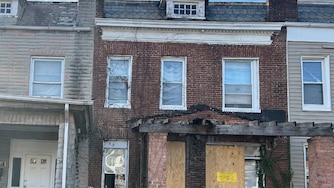As a retired carpenter, Roger Davis was out of his element when he spent countless “miserable” hours reading urban planning documents, scientific papers and county reports about stream restorations. Soon enough, he became a restoration skeptic.
Howard County plans to restore a small stream behind Dunloggin Middle School, near Davis’s Ellicott City home. But the restoration, aimed at reducing erosion, would remove dozens of mature trees from a forested area that Davis says is teeming with wildlife like bald eagles, foxes and herons.
Since 2022, Davis has organized a grassroots campaign to stop the project that he fears would irreversibly degrade the ecosystem. He and more than 100 neighbors have rallied online and at community meetings against it.
That battle is playing out at a larger scale across the state, from legislative debates in Annapolis to grassroots opposition in Baltimore. Stream restoration critics are worried that the restorations are little more than a political scheme to earn federal environmental credits. Others argue that the reality is more complex and that the projects can be initially ugly yet ultimately effective ways to improve water quality.
As opposition across the state grows, similar debates could determine the future of a commonly used tool to reduce pollution in the Chesapeake.

Waterways, dollars and nutrients
Walking by the Ashbrook Drive stream restoration in Ellicott City, completed earlier this year, Davis found the unshaded stream and its algae-clogged water to be a self-evident failure.
Stream restorations usually involve removing large trees in the area so heavy machinery can move in and restructure the stream banks. Crews often unload large rocks and jute matting, which looks like grids of rope, on the site to reduce erosion. Replanted saplings, caged in wire, take the place of felled trees. These projects often aim to rebuild a flood plain ecosystem, which reduces flooding and runoff downstream.
The goal is to limit the nitrogen, phosphorus and sediments that end up in the Chesapeake. Soil in the mid-Atlantic region is often laden with these nutrients from farming decades or even centuries ago, and when they make their way into the bay, they can create algae blooms that cut off sunlight and oxygen for fish, crabs and other underwater wildlife.
Between 2010 and 2020, there were 142 miles of streams restored around the Chesapeake. State and local governments can earn environmental credits for these projects, marking progress toward federally mandated Chesapeake Bay cleanup goals. (Maryland is lagging behind on its state goals.) Counties usually rely on contractors to carry out restoration projects, turning the practice into a lucrative business.
That’s left some people concerned that stream restorations are more about money and politics than the environmental impact, with little accountability for the results.
“It’s a lot easier to count dollars than it is to count nutrients in these waterways,” said Patuxent Riverkeeper Fred Tutman, whose job is monitoring and protecting the health of the Patuxent watershed.
For his part, Howard County’s director of public works, Yosef Kebede, said “the pursuit of credits does not factor in to the rationale” for restoring the stream near Davis’ home, called the Plumtree Branch. He said a concerned science teacher at nearby Dunloggin Middle School contacted the department in 2018 and suggested the stream could benefit from restoration due to visible signs of erosion.
The county has contracted EcoTone to carry out the project. A consultant, Underwood & Associates, will “help evaluate this project again, through an objective lens and seeing what features of the design we might be able to modify to address some of the concerns,” Kebede said. Neither EcoTone nor Underwood & Associates responded to a request for an interview.

Davis cites Howard County’s own assessments as damning evidence against stream restoration. A 2022 Department of Public Works report on the condition of three watersheds post-restoration noted that Columbia’s Wilde Lake watershed, which was restored in 2005, “has not demonstrated measured improvement in either habitat quality or ecological stream health over the seventeen years of monitoring.”
And it said Ellicott City’s Red Hill Branch, which was restored in 2011, was “in an overall degraded ecological condition, with little change from the first two years of pre-restoration monitoring,” though it did note less erosion after the restoration.

Howard County has completed 63 stream restorations since 2012, Safa Hira, a spokesperson for the county, wrote in an email to The Banner.
Hira pointed to the Bramhope Lane stream restoration in Ellicott City as a success in improving water quality. The county monitored the site two years before the restoration and eight years after, finding a significant reduction in nitrogen, phosphorus and sediment runoff, Hira wrote.
Hira also cited the Woodcrest stream restoration in Ellicott City as an example of one that maintained shade over the water. Dozens of small replanted saplings border one side of the stream, while mature trees provide partial shade around them.

The Plumtree Branch restoration will remove 50 mature trees, and 777 saplings will be replanted afterward, Hira wrote in an email. The county can use live stakes (planted tree branches), wood snags (maintained dead trees), and root wads (buried roots and trunks of dead trees) to provide shade in lieu of mature trees, Hira wrote.
“To remove a mature tree and to replace it with a sapling, or a seedling, is at least 50 years, maybe 100 years, of lost benefits that the mature trees provide,” said Doug Myers, senior scientist at the Chesapeake Bay Foundation. “Those trees have lots of benefits, from water quality to quality of life to water temperature.”
The restoration debate
Erik Michelsen, deputy director of Anne Arundel County’s Department of Public Works and chief of the county’s Bureau of Watershed Protection and Restoration, said he is “intimately familiar” with the arguments against stream restoration. But he believes that “the idea that [stream restorations] are credit-chasing is a real oversimplification of what’s actually going on,” he said.
He considers Maryland’s crediting system to be one of the most sophisticated in the country when it comes to water quality management, and says local governments fail to inform the public of what a stream restoration will actually look like.
“It looks like a bomb went off,” he said.
While restoration is “aesthetically displeasing” in the short term, it usually works at preventing runoff, Michelsen said. “I’m sure there are bad stream restoration projects. But I think the difficulty is painting the entire industry or space with a single brush really doesn’t capture the range of things that are going on.”

Scientists like Robert Hilderbrand, on the other hand, are concerned that the focus on runoff comes at the expense of streams’ ecological health.
Hilderbrand, an associate professor at the University of Maryland, has been on a 30-year scientific journey to determine if stream restorations benefit local wildlife. His research, including a study of Montgomery County streams, found that restorations are underwhelming at uplifting the local ecology. One of his studies determined that both restored and nonrestored urban streams had very similar, relatively low populations of animals like trout and mayflies, which are species that can indicate the overall health of an ecosystem.
Hilderbrand thinks that stream restorations in Maryland are in need of long-term data and ecological monitoring. His main concern is that the loss of mature trees can cause a disastrous chain reaction for aquatic wildlife: Less tree cover means more sunlight hits the water, increasing stream temperatures which, when combined with excess nutrients, create algae blooms that reduce oxygen levels.
“I think that a number of streams have been targeted for restorations because of the crediting, not necessarily because the ecology will be improved,” Hilderbrand said. “That is a very big concern of mine.”
Several studies have also found that stream restorations have disappointing impacts.
But Michelsen said several beautiful streams in Anne Arundel are the product of stream restorations. He pointed to a 2020 project in Glen Burnie that restored a stream that was little more than a concrete ditch. “Within a couple of years of that project being completed, we found six fish species, among other critters and whatnot in that system,” Michelsen said. The Broad Creek stream restoration in Annapolis, completed earlier this year, also shows signs of a healthy wetland ecosystem: Small fish and floodplain vegetation are abundant near the redirected stream channel.
Pushing for policy changes
Earlier this year, lawmakers introduced a bill that would have put stronger regulations around stream restoration. Myers, of the Chesapeake Bay Foundation, and Tutman testified in support of the bill. Michelsen of Anne Arundel County testified against it. It ultimately failed.
An independent analysis of the bill found that it could have increased state expenditures by hundreds of millions of dollars each year. Michelsen said he is worried that stronger regulations, fueled by misconceptions about how stream restorations work, would hamper state efforts to improve the Chesapeake.
Tutman is more skeptical and thinks an unregulated free market would prioritize quick and ineffective restoration projects over more holistic, watershed-scale projects. Myers is also skeptical, and believes that conserving mature trees should be a priority for the state.
As Gov. Moore was recently elected as chair of the Chesapeake Executive Council, eyes are on Maryland and its Chesapeake cleanup initiatives. Opposition to a restoration project in Baltimore City echoed the concerns voiced by the Chesapeake Bay Foundation and Blue Water Baltimore in their lawsuit against the state for its stormwater permitting in Baltimore City and Baltimore County.
Meanwhile, in Ellicott City, Davis finds it hard to imagine the loss of dozens of trees around the stream that his family grew up playing among. The Plumtree Branch project has been in a thirty-day comment period that will wrap up by early November, Kebede of the public works department said.





Comments
Welcome to The Banner's subscriber-only commenting community. Please review our community guidelines.